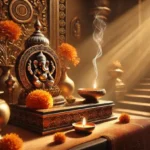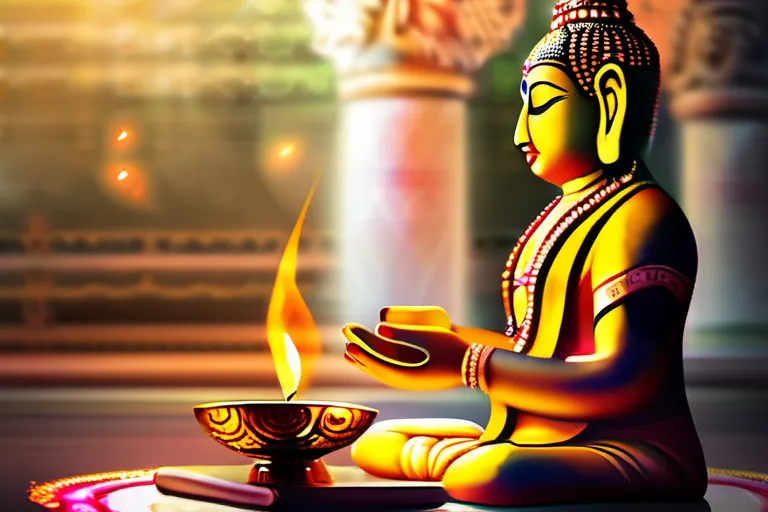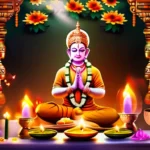Explore the history, purpose, and types of pujas in Hinduism and Buddhism.
Pujas are an integral part of Hinduism and Buddhism. In this article, we delve into the meaning, significance, and various types of pujas, providing a comprehensive guide for understanding their importance.
The Origin and Evolution of Pujas
Imagine stepping back through time, where rituals played a central role in daily life and spirituality. Pujas, those intricate ceremonies that involve prayers, offerings, and invocations, have their roots deeply embedded in the ancient soil of Hinduism and Buddhism.
What were the earliest forms of pujas? In the Vedic era, before the formation of formal religious texts like the Vedas, rituals were simple yet powerful. They involved chanting mantras, performing fire sacrifices, and invoking deities to seek blessings or protection. Over centuries, these practices evolved into more structured and elaborate ceremonies.
The evolution of pujas in Buddhism is equally fascinating. Although it originated as a reform movement within Hinduism, Buddhism developed its own unique rituals that emphasized meditation, chanting, and the veneration of Buddha images. These practices were designed to foster mindfulness and inner peace rather than the external worship seen in some Hindu traditions.
How did these ceremonies adapt over time? With the spread of both religions across vast regions, pujas took on diverse forms. In Southeast Asia, for example, local cultures infused their own customs into Buddhist practices, creating unique rituals that reflect regional beliefs and values. Similarly, in India, Hindu pujas became increasingly elaborate, with intricate rituals and rich symbolism.
As time passed, the significance of pujas extended beyond personal devotion to communal harmony. They became a means of connecting individuals not just with deities but also with their communities. These ceremonies serve as a reminder that our spiritual journeys are deeply intertwined with the fabric of society.
The journey of pujas from ancient practices to modern rituals is a testament to human spirituality’s enduring power. As we continue to witness the evolution, it’s clear that these ceremonies remain a vital link between the past and present, offering timeless wisdom for our contemporary lives.
The Purpose and Significance of Pujas
Imagine a world where every morning, you wake up to rituals that connect you with the divine and bring harmony into your life. In Hinduism and Buddhism, pujas serve just this purpose – they are the keys to unlocking spiritual pathways and maintaining balance in one’s existence. But what exactly is a puja? And why do these rituals hold such significance?
A puja can be defined as a ritual worship or ceremony performed by Hindus and Buddhists to honor deities, ancestors, or other revered beings. It’s like setting up a sacred stage where the spiritual world meets the physical one. By performing pujas, practitioners believe they are not just worshipping but also inviting blessings and divine energies into their lives.
When you step into a temple during a puja, it feels like stepping back in time, where ancient traditions blend with modern practices. The chanting, the lights, the offerings – every element is designed to invoke a sense of peace and devotion. This ritual isn’t just about following rules; it’s an act of connecting with something greater than yourself.
So why do pujas matter? They are more than mere ceremonies—they are spiritual practices that nourish the soul. By engaging in these rituals, one can experience a profound sense of inner peace and fulfillment. It’s like planting seeds of positivity—over time, these acts grow into a rich garden of spirituality.
In both Hinduism and Buddhism, pujas play a crucial role in maintaining harmony and balance not just for individuals but for entire communities. They are threads that weave together the fabric of religious life, connecting past to present and ensuring continuity with tradition. Just as a tapestry gains strength from its intricate patterns, society benefits from these rituals that reinforce cultural values and spiritual beliefs.
As we delve deeper into understanding pujas, it becomes clear that they are not just about devotion but also about living in harmony with the world around us. They offer a bridge between the mundane and the divine, allowing us to find meaning and purpose in our daily lives. In this journey of spiritual exploration, pujas become our guiding lights, illuminating paths to inner peace and enlightenment.
Types of Pujas: A Comprehensive Overview
Understanding the significance of pujas involves delving into their diverse and intricate forms, each tailored to specific needs and occasions. Let’s explore the various types of pujas that grace both Hinduism and Buddhism, bringing us closer to understanding their profound impact.
- Daily Pujas: These are the most common and often involve a simple yet meaningful ritual. Daily pujas serve as a daily reminder to connect with one’s spiritual self and seek blessings for everyday life. They typically include offerings of flowers, incense, and light, symbolizing devotion and gratitude.
- Monthly Pujas: Monthly rituals often align with the lunar cycle, marking significant days such as full moon or new moon. These pujas are more elaborate and are performed to seek blessings for prosperity, health, and protection against negative energies. They may involve recitations of prayers and chanting mantras.
- Annual Pujas: These ceremonies are grander in scale and significance, often held once a year or during major festivals like Diwali or Durga Puja. Annual pujas aim to invoke the blessings of deities for long-term benefits and are usually community events, fostering unity and spiritual growth.
- Special Occasion Pujas: These pujas are performed on specific occasions such as weddings, childbirth, or naming ceremonies. They serve to bless the event and ensure the presence of positive energies. Special occasion pujas often involve a wider range of rituals including traditional music, dance, and elaborate offerings.
Each type of puja is like a key that unlocks a specific door in your spiritual journey, offering unique benefits based on when and why it’s performed. By understanding the nuances of these different pujas, we gain insight into how they enrich our lives and communities with spiritual depth and meaning.
The Rituals and Symbols of Pujas
Understanding the significance of pujas involves delving into their rich history and exploring the intricate layers of symbolism and ritual. Have you ever wondered how these ancient practices have stood the test of time, resonating through generations? Pujas are like the veins in a tree—rooted deeply in tradition yet branching out to touch every aspect of spiritual life.
In both Hinduism and Buddhism, pujas are more than just ceremonies; they are vibrant expressions of faith and devotion. Imagine a puja as a grand symphony where each ritual is an instrument playing its part, creating a harmonious melody that resonates with the divine. Each symbol, offering, and invocation holds profound meaning, weaving together layers of spiritual significance.
Let’s explore some common symbols found in pujas:
- Sandalwood paste: This is often applied to deities or idols as a sign of respect and purity. It’s like giving the divine a warm embrace, invoking feelings of calm and peace.
- Flowers: Offered in baskets or scattered around, flowers symbolize beauty and fleeting life, reminding us of the transient nature of existence.
- Aarti lamps: The flickering flames of these lamps represent light dispelling darkness, a metaphor for wisdom overcoming ignorance. Holding an aarti lamp is like carrying a torch through life’s shadows, guiding us towards enlightenment.
- Rice grains and pulses: These offerings are often scattered in front of the deity as symbols of prosperity and abundance, akin to sowing seeds that promise a bountiful harvest.
These rituals aren’t just about following tradition; they are a way of connecting with the divine on an emotional and spiritual level. Think of them as keys opening doors to different realms of consciousness, allowing us to experience the sacred in our daily lives. Whether you’re familiar with pujas or new to this practice, understanding their symbolism can deepen your appreciation for these beautiful rituals.
Performing a Puja: A Step-by-Step Guide
Imagine standing before a sacred altar, surrounded by flickering lights and the faint scent of incense. Have you ever wondered what it feels like to perform a puja in person? It’s not just a ritual; it’s a profound connection to your spiritual roots. Let’s dive into the step-by-step process of performing a puja, from preparation to completion.
1. Setting Up Your Space: First and foremost, choose a quiet corner where you can place an altar or simple table. This space should be clean and free from clutter. Think of it as preparing your battlefield—clear and ready for battle against spiritual challenges!
2. Invoking the Deity: Before starting any ritual, invite the deity into your presence. Light a candle or incense stick to symbolize the divine light entering your space. Imagine the deity standing before you, watching over the proceedings.
‘Do you feel a sense of reverence as you place these items on your altar?’ asks the wise priest, guiding you through this sacred act.
3. Reciting Mantras: Chanting mantras is a central part of many pujas. Select a mantra that resonates with your intention—maybe it’s protection, wealth, or enlightenment. Repeat these words aloud or silently, allowing the vibrations to fill the air.
‘Isn’t it like whispering secrets into the wind?’ whispers the priest, encouraging you to trust in the power of sound and spirit.
4. Offering Prayers: Offer prayers that reflect your deepest wishes and desires. You might use flowers, fruits, or sweets as offerings. These symbols represent not just material gifts but also the essence of devotion and gratitude.
‘Do you see the beauty in transforming everyday items into sacred gifts?’ muses the priest, helping you understand the symbolism behind each offering.
5. Performing Abhisheka: This involves pouring water or milk over a deity’s image to wash away impurities and cleanse the soul. It’s like giving your spiritual counterpart a refreshing bath!
‘Can you feel the purity of the waters as they symbolically cleanse both body and mind?’ asks the priest, guiding you through this act of purification.
6. Closing the Puja: As the ritual draws to a close, make sure to express your gratitude for the blessings received. Bow deeply or offer a prayer to thank the deity. It’s like saying goodbye to an old friend who has shared their wisdom and grace with you.
‘Do you feel lighter, more at peace after this journey?’ the priest asks, guiding you through the final moments of your puja experience.
The Impact of Pujas on Society and Culture
The impact of pujas on society and culture cannot be overstated. They serve as a bridge, connecting people to their spiritual roots and fostering a sense of community. Have you ever wondered how these rituals play such a significant role in maintaining cultural traditions? Let’s delve into the social and cultural significance of pujas.
In Hinduism and Buddhism, pujas are more than just religious ceremonies; they are vibrant expressions of faith and devotion. These gatherings often bring communities together, acting as a unifying force in diverse societies. Imagine a village square where people from all walks of life come together to honor the divine – wouldn’t that be a powerful symbol of unity? Pujas serve precisely this purpose, bringing people closer through shared rituals and offerings.
The role of pujas in preserving traditions cannot be overlooked. Through these ceremonies, ancient practices are kept alive, ensuring that generations to come can connect with their cultural heritage. It’s like carrying a torch, where each generation adds its light to the flame, keeping it burning brightly. Do you think about how your ancestors might have participated in similar rituals? Pujas help keep those memories and traditions alive.
Moreover, pujas play a crucial role in fostering community spirit. They provide a platform for people to come together, share their beliefs, and celebrate life’s milestones. Whether it’s a birth, marriage, or even simple thanksgiving, pujas offer a communal space where everyone feels welcomed and valued. These gatherings are like a tapestry, woven with threads of love, respect, and shared joy.
But the impact of pujas extends beyond mere community building; they also help in spreading awareness about cultural values and practices. By participating in these rituals, individuals not only deepen their own spiritual understanding but also contribute to the broader cultural dialogue. It’s like a ripple effect – one person’s participation can inspire others, creating a wave of interest and appreciation for the rich tapestry of traditions.
In essence, pujas are more than just religious practices; they are lifelines that keep cultures vibrant and alive. They remind us of our collective heritage and encourage us to celebrate it with pride and passion. So, the next time you participate in a puja, remember its profound impact on your community and culture.
Note: These insights highlight how pujas serve as both a reflection and a reinforcement of cultural traditions, making them invaluable assets in our collective social fabric.
Conclusion
 By gaining a deeper understanding of pujas, you will appreciate the rich cultural heritage they represent and learn how to perform them with reverence and respect.
By gaining a deeper understanding of pujas, you will appreciate the rich cultural heritage they represent and learn how to perform them with reverence and respect.











